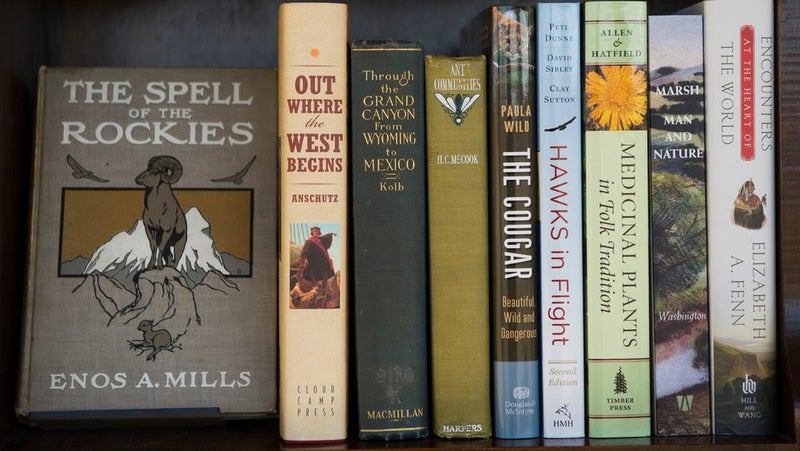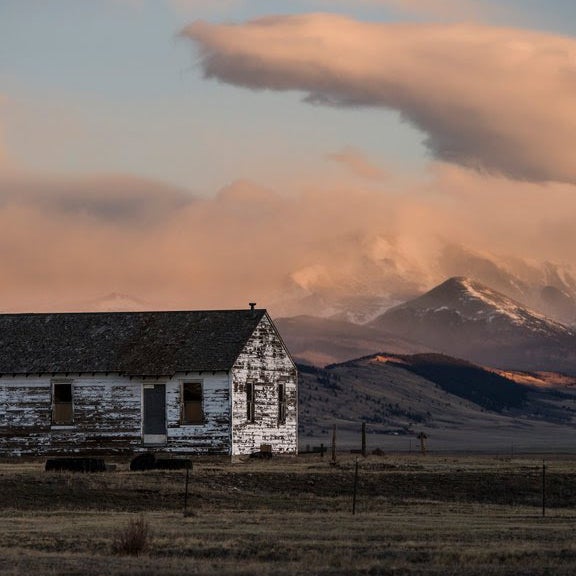For nearly 30 years, Jeff Lee and his wife, Ann Martin, have been gathering books—more than 35,000—to fill the shelves of a library that honors the literature, history, and culture of land. They’ll finally unveil the this fall.
The library is housed at the historic Buffalo Peaks Ranch, a former cattle operation in South Park, Colorado. Three years ago, the couple signed a lease to grant ownership of the ranch for the next 95 years. “It captured us with its stunning landscape, but also its history,” Lee says of the ranch, which was built in the 1860s. “You can feel it all around you.”
Since 2008, the Land Library team has raised more than $150,000 through grants and personal investments. The money will primarily go toward renovating one of the ranch’s oldest buildings, the Cook’s House, which will be used for guest lodging. They hope to raise about for that project by the end of the month, and they’ll need to raise about $6 million for all renovations in the coming years. Lee says he’s especially shocked by how many people in their twenties have contributed and shown interest in joining his all-volunteer staff. “That was always a big question for us: And God, we’ve gotten such overwhelming enthusiasm from these young folks.”

The couple was first inspired by , a residential library in Flintshire, North Wales, where visitors can stay overnight, take classes, and explore more than 32,000 books. For the Land Library, Lee and Martin bought about 30,000 books; about 5,000 more were donated. They credit their experiences working at the , in Colorado, for what they believe is a near-perfect repertoire of natural history literature. “We’ve always tried making our collection about the people and the land, but that’s taken us in so many different subject areas,” Lee says. “These are wonderful reads, and we can’t wait to put them on the shelves.”
We asked Lee to pick six of his personal favorites from the vast collection.
‘Jellyfish: A Natural History,’ Lisa-Ann Gershwin
Upon asking Lee for his favorite book in the Land Library collection, there wasn’t a moment of pause before he chose . “It’s a stunningly gorgeous photo book with great text—kind of like a field guide approach to jellyfish across the world,” he says. “It’s one of those books where this feeling comes over you, and you think, ‘Wow! What an amazing, unexpected planet we live on.’”
‘The Wild Places,’ Robert Macfarlane
In , Robert Macfarlane explores the concept of “wild,” searching for any remaining untouched places throughout England, Britain, Wales, and Ireland. He embarks on a series of journeys—climbing, hiking, swimming, and camping through some of the archipelago’s most stunning landscapes. Though Macfarlane eventually alludes to the ghastly destruction of our natural world, he remains unwilling to accept its demise. “He’s just a beautiful writer,” Lee says. “I don’t want to give too much away, but it basically concludes that you can find wild places anywhere you are. You just have to look around you: up at the sky and into the woods.”
‘Unseen City: The Majesty of Pigeons, the Discreet Charm of Snails, and Other Wonders of the Urban Wilderness,’ Nathanael Johnson
“This is on our shelves,” says Lee. It’s the story of Johnson and his daughter’s daily journeys through San Francisco. Though Nathanael Johnson’s initial aim is to teach his daughter the name of every tree they pass en route to daycare, the project eventually evolves into a quest of full-blown trivia about the city’s flora and fauna and a reflection on living a more attentive life. The book also becomes a meditation on how nature can shift perspective and how we can find the “wild” all around.
‘The Emerald Mile: The Epic Story of the Fastest Ride in History Through the Heart of the Grand Canyon,’ Kevin Fedarko
Some called it bravery (others, insanity) when Kenton Grua revamped an old flat-bottomed fishing boat named the Emerald Mile with the intent of racing it down turbulent whitewater flood rapids. In this book, �����ԹϺ��� contributor Kevin Fedarko recreates that 1983 speed record along Grand Canyon’s roaring Colorado River. In the process, he reveals the strange ways that our passions, and the wild places we’re drawn to, reflect who we are at the core. “Fedarko is a born storyteller, and his book is much more than a wild adventure,” says Lee. “It might be in the West that we have.”
‘On Trails: An Exploration,’ Robert Moor
While thru-hiking the Appalachian Trail in 2009, Robert Moor became increasingly curious about the land he was exploring. For the next seven years, he traveled the world, surveying a variety of other trails and asking: how does technology alter the human relationship with nature? What techniques do humans use to dissolve the chaos of wilderness? And how does an individual stay true to their figurative life’s path?
Lee tells me the Land Library already has four copies of . “Our amazing architecture and planning team passes copies around often, liberally quoting the book along the way,” he says. “There’s something about Moor’s writing that just inspires them.”
‘My Green Manifesto: Down the Charles River in Pursuit of a New Environmentalism,’ David Gessner
is “an always surprising, brilliantly written book that challenges us to fall in love with a particular place in our lives and fight like hell to save it,” Lee says. David Gessner’s manifesto is a retelling of a canoe trip down Boston’s Charles River with his friend Dan Driscoll, an energetic, pot-smoking environmentalist who has spent approximately 20 years working to save the infamously toxic river. Throughout the book, Gessner wrestles with the meaning of environmentalism in the modern world. Although he eventually concludes that his friend might never be able to legitimately save the river, Gessner is inspired by the lifelong commitment to at least try.


